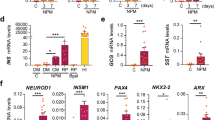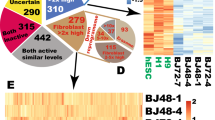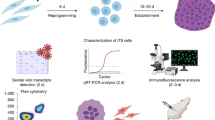Abstract
We demonstrate here the functional reprogramming of a somatic cell using a nuclear and cytoplasmic extract derived from another somatic cell type. Reprogramming of 293T fibroblasts in an extract from primary human T cells or from a transformed T-cell line is evidenced by nuclear uptake and assembly of transcription factors, induction of activity of a chromatin remodeling complex, histone acetylation, and activation of lymphoid cell–specific genes. Reprogrammed cells express T cell–specific receptors and assemble the interleukin-2 receptor in response to T cell receptor–CD3 (TCR–CD3) complex stimulation. Reprogrammed primary skin fibroblasts also express T cell–specific antigens. After exposure to a neuronal precursor extract, 293T fibroblasts express a neurofilament protein and extend neurite-like outgrowths. In vitro reprogramming of differentiated somatic cells creates possibilities for producing isogenic replacement cells for therapeutic applications.
This is a preview of subscription content, access via your institution
Access options
Subscribe to this journal
Receive 12 print issues and online access
$209.00 per year
only $17.42 per issue
Buy this article
- Purchase on Springer Link
- Instant access to full article PDF
Prices may be subject to local taxes which are calculated during checkout






Similar content being viewed by others
References
Gurdon, J.B. & Uehlinger, V. “Fertile” intestine nuclei. Nature 210, 1240–1241 (1966).
Wilmut, I., Schnieke, A.E., McWhir, J., Kind, A.J. & Campbell, K.H.S. Viable offspring derived from fetal and adult mammalian cells. Nature 385, 810–813 (1997).
Cibelli, J.B. et al. Cloned transgenic calves produced from nonquiescent fetal fibroblasts. Science 280, 1256–1258 (1998).
Cibelli, J.B. et al. Transgenic bovine chimeric offspring produced from somatic cell–derived stem-like cells. Nat. Biotechnol. 16, 642–646 (1998).
Munsie, M.J. et al. Isolation of pluripotent embryonic stem cells from reprogrammed adult mouse somatic cell nuclei. Curr. Biol. 10, 989–992 (2000).
Wakayama, T. et al. Differentiation of embryonic stem cell lines generated from adult somatic cells by nuclear transfer. Science 292, 740–743 (2001).
Tada, M., Takahama, Y., Abe, K., Nakatsuji, N. & Tada, T. Nuclear reprogramming of somatic cells by in vitro hybridization with ES cells. Curr. Biol. 11, 1553–1558 (2001).
Tada, M., Tada T., Lefebvre, L., Barton, S.C. & Surani, M.A. Embryonic germ cells induce epigenetic reprogramming of somatic nucleus in hybrid cells. EMBO J. 16, 6510–6520 (1997).
Surani, M.A. Reprogramming of genome function through epigenetic inheritance. Nature 414, 122–128 (2001).
Morrison, S.J. Stem cell potential: can anything make anything? Curr. Biol. 11, R7–R9 (2001).
Hu, E., Tontonoz, P. & Spiegelman, B.M. Transdifferentiation of myoblasts by the adipogenic transcription factors PPARγ and C/EBPα. Proc. Natl. Acad. Sci. USA 92, 9856–9860 (1995).
Shen, C.N., Slack, J.M. & Tosh, D. Molecular basis of transdifferentiation of pancreas to liver. Nat. Cell Biol. 2, 879–887 (2001).
Funderburgh, J.L., Funderburgh, M.L., Mann, M.M., Corpuz, L.M. & Roth, M.R. Proteoglycan expression during transforming growth factor β–induced keratocyte–myofibroblast transdifferentiation. J. Biol. Chem. 276, 44173–44178 (2001).
Condorelli, G. et al. Cardiomyocytes induce endothelial cells to trans-differentiate into cardiac muscle: implications for myocardium regeneration. Proc. Natl. Acad. Sci. USA 98, 10733–10738 (2001).
Wangh, L.J., DeGrace, D., Sanchez, J.A., Golf, A. & Yeghiazarians, Y. Efficient reactivation of Xenopus erythrocyte nuclei in Xenopus egg extracts. J. Cell Sci. 108, 2187–2196 (1995).
Kass, S., Pruss, D. & Wolffe, A. How does DNA methylation repress transcription? Trends Genet. 13, 444–449 (1997).
Kikyo, N., Wade, P.A., Guschin, D., Ge, H. & Wolffe, A.P. Active remodeling of somatic nuclei in egg cytoplasm by the nucleosomal ATPase ISWI. Science 289, 2360–2362 (2000).
Crabtree, G.R. Contingent genetic regulatory events in T lymphocyte activation. Science 243, 355–361 (1989).
Ward, S.B. et al. Chromatin remodeling of the interleukin-2 gene: distinct alterations in the proximal versus distal enhancer regions. Nucleic Acids Res. 26, 2923–2934 (1998).
Lin, J. & Weiss, A. T cell receptor signalling. J. Cell Sci. 114, 243–244 (2001).
Skålhegg, B.S. et al. Location of cAMP-dependent protein kinase type I with the TCR–CD3 complex. Science 263, 84–87 (1994).
Zhao, K. et al. Rapid and phosphoinositol-dependent binding of the SWI/SNF-like BAF complex to chromatin after T lymphocyte receptor signaling. Cell 95, 625–636 (1998).
O'Neill, L.P. & Turner, B.M. Histone H4 acetylation distinguishes coding regions of the human genome from heterochromatin in a differentiation-dependent but transcription-independent manner. EMBO J. 14, 3946–3957 (1995).
Kaempfer, R. Regulation of the human interleukin-2/interleukin-2 receptor system: a role for immunosuppression. Proc. Soc. Exp. Biol. Med. 206, 176–180 (1994).
Miyazaki, T. & Taniguchi, T. Coupling of the IL2 receptor complex with non-receptor protein tyrosine kinases. Cancer Surv. 27, 25–40 (1996).
Debus, E., Weber, K. & Osborn, M. Monoclonal antibodies specific for glial fibrillary acidic (GFA) protein and for each of the neurofilament triplet polypeptides. Differentiation 25, 193–203 (1983).
Collas, P., Le Guellec, K. & Tasken, K. The A-kinase anchoring protein, AKAP95, is a multivalent protein with a key role in chromatin condensation at mitosis. J. Cell Biol. 147, 1167–1180 (1999).
O'Neill, L.P. & Turner, B.M. Immunoprecipitation of chromatin. Methods Enzymol. 274, 189–197 (1996).
Steen, R.L., Cubizolles, F., Le Guellec, K. & Collas, P. A-kinaseanchoring protein (AKAP)95 recruits human chromosome-associated protein (hCAP)-D2/Eg7 for chromosome condensation in mitotic extract. J. Cell Biol. 149, 531–536 (2000).
Collas, P., Liang, M.-R., Vincent, M. & Aleström, P. Active transgenes in zebrafish are enriched in acetylated histone H4 and dynamically associate with RNA Pol II and splicing complexes. J. Cell Sci. 112, 1045–1054 (1999).
Collas, P. Modulation of plasmid DNA methylation and expression in zebrafish embryos. Nucl. Acids Res. 26, 4454–4461 (1998).
Acknowledgements
We are grateful to T. Küntziger, A. Spurkland, and Y. Qi for discussion, primers, probes, and technical assistance. This work was supported by the Research Council of Norway and Nucleotech, LLC. P.C. is a fellow of the Norwegian Cancer Society.
Author information
Authors and Affiliations
Corresponding author
Ethics declarations
Competing interests
Part of this project was funded by Nucleotech, LLC, and A.-M.H. was employed by Nucleotech, LLC, during the completion of this work. The nuclear and cell reprogramming methods described here are the property of Nucleotech, LLC (PCT application no. PCT/US 01/47882).
Rights and permissions
About this article
Cite this article
Håkelien, AM., Landsverk, H., Robl, J. et al. Reprogramming fibroblasts to express T-cell functions using cell extracts. Nat Biotechnol 20, 460–466 (2002). https://doi.org/10.1038/nbt0502-460
Received:
Accepted:
Issue Date:
DOI: https://doi.org/10.1038/nbt0502-460
This article is cited by
-
Improving knowledge on the activation of bone marrow fibroblasts in MGUS and MM disease through the automatic extraction of genes via a nonnegative matrix factorization approach on gene expression profiles
Journal of Translational Medicine (2018)
-
Induction of male germ cell-like lineage from chicken fetal bone marrow stem cells with chicken testis extract
Biotechnology and Bioprocess Engineering (2017)
-
Creation of a library of induced pluripotent stem cells from Parkinsonian patients
npj Parkinson's Disease (2016)
-
Plasticity of granulosa cells: on the crossroad of stemness and transdifferentiation potential
Journal of Assisted Reproduction and Genetics (2013)
-
Production of erythriod cells from human embryonic stem cells by fetal liver cell extract treatment
BMC Developmental Biology (2010)



